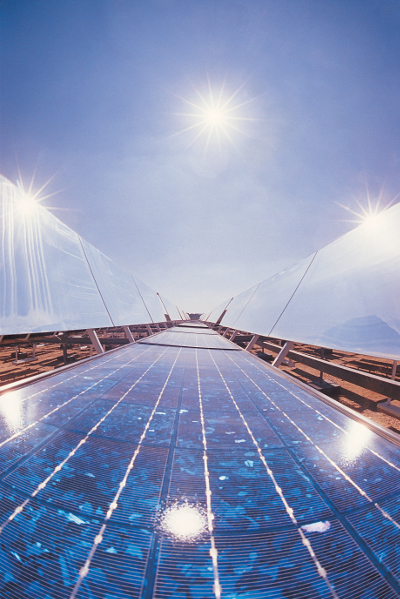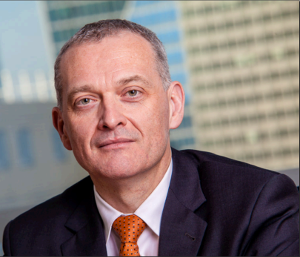Saudi Arabia should turn to the sun
Published online 5 January 2015
Jean-Luc Bredas and Marc Vermeersch believe that a concerted move in Saudi Arabia toward renewable energy sources, including solar, is essential.
Jean-Luc Bredas and Marc Vermeersch
© Getty Images/Thinkstock Images
Projections show that a looming gap between demand and the installed electric capacity in Saudi Arabia is a very real possibility.
Saudi Arabia’s rapid economic development and population growth has driven the surge in electricity demand, which is expected to exceed 120GW by 2032. At the current rate of development, this could create a gap between the projected installed power capacity and the projected peak demand of 60GW in 2032.
There are several options that could fill this gap. The country could scale up traditional power generators using oil, depleting a finite national reserve that could be allocated to applications of higher added value and worsening climate change in the long run.
Alternatively, the country could turn to nuclear power, which can provide a stable baseload coverage but which raises safety issues. Following the events of the near meltdown of the nuclear power plant in Fukushima, most countries are moving away from nuclear energy. The environmental impact of this choice depends on risk management associated to the equipment, nuclear fuel, and nuclear wastes life cycles.
A third option is to improve existing installations while adjusting the specifications of future installations in terms of efficiency and energy management.
A fourth scenario is based on the development of renewable sources of energy, and for ever-sunny Saudi Arabia, solar energy may be one of the most viable option.
Not to say that an “energy mix” is not needed; in fact all sources of energy should be combined and optimised. Because until large-scale – centralized or distributed – storage solutions are available and operational, power stability will require a significant level of conventional hydrocarbon electricity generation.
Based on this, the King Abdullah City for Atomic and Renewable Energy (KACARE) programme is recommending up to 50% of electricity generation be covered by non-conventional sources, like solar, by 2032. The corresponding energy mix would be built on hydrocarbons (60GW), nuclear (17.6GW), solar (41GW with 16GW from PV and 25GW from CSP), wind (9GW), waste-to-energy (3GW) and geothermal (1GW).
Tapping into the Sun
Solar is perhaps the safest and most sustainable source of primary energy – based on a stable nuclear fusion reactor – delivering nearly 1,500 times the energy needs of all humans. Saudi Arabia has one of the highest irradiation levels on Earth, exceeding 2000kWh/m2/year. This could be the genesis of one of the world’s lowest levelized costs of electricity (LCOE) for renewables – around US$70-90/MWh, which is close to the cost of natural gas CCGT and coal generated electricity – provided the appropriate choice of energy conversion technologies and installations is made.
In terms of environmental footprint and climate change risk mitigation, life cycle analyses show us that the energy payback time of solar photovoltaics is of one to three years and the CO2 balance is by far more favourable.
Saudi Arabia has an ambitious programme to produce almost half its electricity from renewable sources by 2032 - a target that represents a substantial proportion of the total power produced globally by then from renewable sources.
There are several challenges in reaching this ambitious target. Subsidies, and increased exploitation of new oil sources, weaken the competitiveness of renewable energy and dampen its appeal.
This raises fundamental questions over the Kingdom’s ambition:
- The ability of the existing grid infrastructure to absorb and manage in a stable manner this new, fluctuating contribution to electricity generation. We believe the current infrastructure is poorly adapted to manage renewables. On the other end, this weakness could be turned around to represent an outstanding opportunity for the Kingdom to build a modern grid suited for a portfolio of energy sources;
- The availability of resources in the Kingdom to support such a development and the integration of the portfolio of energy sources. These range from human resources covering the value chain in terms of competencies, skills and know-how to manufacture, install, operate and maintain these installations, to raw materials to be transformed into semi-products, products and equipment;
- The conditions to which the equipment used in electricity generation will be exposed. There are valid concerns regarding their suitability for the Kingdom’s high operating temperatures, humidity and dust levels. Standard test conditions for equipment certification do not systematically include environmental conditions which are very specific to the Middle East. Extreme care should therefore be taken during the technology and equipment selection.
The Kingdom’s renewable energy target is challenging and needs work on several strategic axes of development.
The pace of development envisioned will require appropriate partnerships to be established with existing industrial players to bring the technologies needed to the Kingdom. This will need to cover the entire value chain – from raw material to system integration, while guaranteeing job creation.
A large proportion of the raw materials, semi-products and equipment will have to be imported into the country.
Should these partnerships bring about any significant technical developments in the country, intellectual property rights, from invention protection to licensing, would have to be addressed.
Research and development will be the driving force for this push for renewable energy. In the short and medium-term, the country will need technical and scientific expertise to better assess a great variety of technologies and to cover equipment selection, evaluation and testing.
In the future, technical work and solid research will enable the country’s stakeholders to establish the corresponding ‘building blocks’ for current and future technology generation.
Finally, citizens will be the main players in this development. It will be essential to align people’s skills and know-how with requirements brought by these technologies, and to guarantee sustainability and reliability.
Our vision
Our goal as a centre is to marry efforts from materials research in emerging solar technologies to system engineering in established technologies in order to contribute to sustainably develop the future energy mix the Kingdom needs.
The mission of the Solar and Photovoltaic Engineering Research Center (SPERC) at King Abdullah University of Science and Technology (KAUST) is aligned with the key factors of development mentioned above, as they are all important drivers for our research and education activities. The centre places a strong emphasis on research, development, and technology transfer, as well as on education of the next-generation workforce. It brings together scientific and technical expertise supported by a strong network of academic and industrial partners.
The market brings other important factors, as well as the maturity of the industrial network addressing it. As a research and engineering centre, our performance baseline is defined by the competition with regard to both industrial and academic laboratories. Our targets are therefore defined as a function of this baseline.
For example, the photovoltaic market is dominated – almost 90% – by crystalline silicon. The highest efficiency requires high-quality silicon wafers, advanced cell architectures, and relatively few processing steps. These specifications drive our research strategy as a lever to support the Kingdom’s ambitions.
As mentioned above, value chain integration – upstream towards the raw materials in order to reduce their contribution to the cost of ownership (COO), and downstream towards system integration – is a critical step to guarantee that photovoltaic technologies can efficiently deliver the power they are expected to produce.
At the same time, emerging technologies that can shape the future – and that could also be derived from various fields such as semiconductors and microelectronics, advanced ceramics or even biology – have to be integrated in our research roadmap to anticipate and possibly catalyse the potential breakthroughs that could dramatically change the game in energy fields. Examples are the organic- and perovskite-based cells, as well as their combination in advanced architectures with existing cells.
In light of this fast-evolving realm – contributed to by several facets of multidisciplinary scientific fields which integrate technical, economical and geopolitical expertise – our goal as a centre is to marry efforts from materials research in emerging solar technologies to system engineering in established technologies in order to contribute to sustainably develop the future energy mix the Kingdom needs.
Jean-Luc Bredas is the director of the Solar and Photovoltaics Engineering Research Center at King Abdullah University of Science and Technology, and Marc Vermeersch is its managing director.
Saudi Arabia should turn to the sun - Features - Nature Middle East











